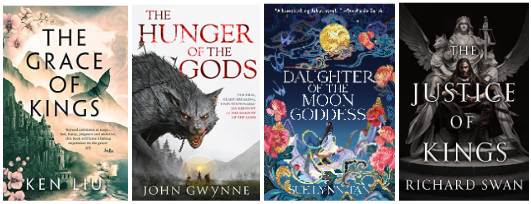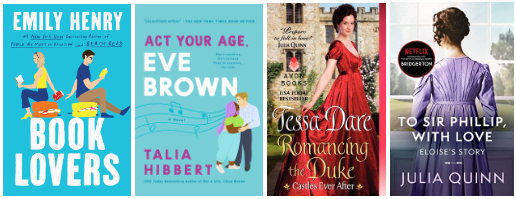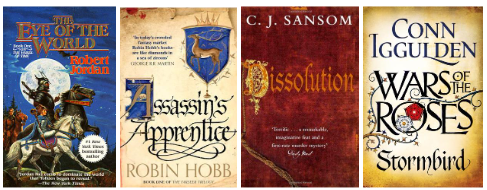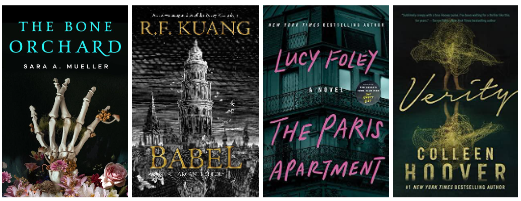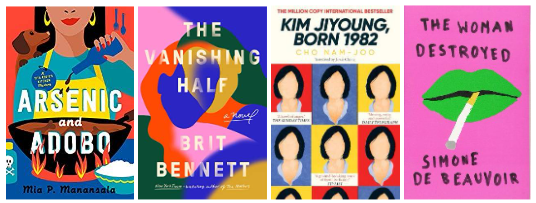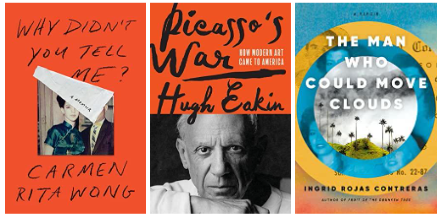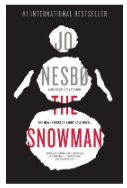Beth Barany's Blog, page 20
October 3, 2022
Empowering Your Practical Writing Life with Beth Barany – Create Your Story Podcast Interview
Terri Connellan recently hosted me on her Create Your Story Podcast where we discussed story-telling, empowering women, and discovering your best writing process.
Have a listen to the show on Apple Podcasts / Google Podcasts / Spotify and Amazon Music or click the link below to have a listen on Youtube.
NOTES FROM THE SHOWBeth Barany shares insights on fiction writing, story-telling, empowering women, and practical writing and self-publishing tips.
Welcome to Episode 19 of the Create Your Story Podcast on Fiction Writing and Empowering Your Practical Writing Life. I’m joined by Beth Barany, award-winning author, multi-genre writer, creativity coach, and teacher.
Full transcript here:
https://www.quietwriting.com/fiction-writing-empowering-your-practical-writing-life-beth-barany/
We covered:
Choosing fiction writing Genre fiction and life stories World-building and dialoguing with characters Centring women in stories as main charactersWomen’s power to negotiate in story and life Creative coaching for genre fiction writers Writing the best way that works for you Discovering your best writing process Beth’s writing process and rituals Top practical productivity tips for writers Filling your well creatively Self-publishing tips and processes.About Beth Barany Award winning author, Beth Barany writes in several genres including young adult adventure fantasy, paranormal romance, and science fiction mysteries. Inspired by living abroad in France and Quebec, she loves creating magical tales of romance, mystery, and adventure that empower women and girls to be the heroes of their own lives. For her day job, Beth helps other novelists write, publish, and market their books as a creativity coach and a teacher.
Award winning author, Beth Barany writes in several genres including young adult adventure fantasy, paranormal romance, and science fiction mysteries. Inspired by living abroad in France and Quebec, she loves creating magical tales of romance, mystery, and adventure that empower women and girls to be the heroes of their own lives. For her day job, Beth helps other novelists write, publish, and market their books as a creativity coach and a teacher.
Website: author.bethbarany.com/
Twitter: twitter.com/bethbarany
LinkedIn: linkedin.com/in/bethbarany/
Terri Connellan is a certified life coach, author and accredited psychological type practitioner. She has a Master of Arts in Language and Literacy, two teaching qualifications and a successful 30-year career as a teacher and a leader in adult vocational education. Her coaching and writing focus on creativity, personality and self-leadership—especially for women in transition to a life with deeper purpose. Terri works with women globally through her creative business, Quiet Writing, encouraging deeper self-understanding of body of work, creativity and psychological type for more wholehearted and fulfilling lives. Terri supports women in writing and publishing their wholehearted stories. Her book Wholehearted: Self-leadership for women in transition and the Wholehearted Companion Workbook were published in 2021 by the kind press. She lives and writes in a village on the outskirts of Sydney surrounded by beach and bush.
You can connect with Terri at QuietWriting.com and on social media as @writingquietly on Instagram, Facebook and Twitter.
BooksWholehearted: Self-leadership for women in transition
quietwriting.com/wholehearted-book
quick links to buy: books2read.com/wholehearted
Wholehearted Companion Workbook
quietwriting.com/wholehearted-companion-workbook
& quick links to buy: books2read.com/b/companion
Chapter 1 of Wholehearted: Self-leadership for women in transition
quietwriting.net/wholehearted-chapter-1
Personal Action Checklist for Creating More Meaning + Purpose
quietwriting.net/checklist
Work with me: quietwriting.com/work-with-me/
The Writing Road Trip with Beth Cregan: quietwriting.net/writingroadtrip
LinkedIn: linkedin.com/in/terri-connellan/
***
For more interviews with Beth, click here.
If you’d like to invite Beth onto your podcast, drop her a note here.
The post Empowering Your Practical Writing Life with Beth Barany – Create Your Story Podcast Interview appeared first on Writer's Fun Zone.
September 20, 2022
Should a Pantser Try to be a Plotter? One Pantser’s Shocking True Story By Laurel Osterkamp
 Let’s welcome back Laurel Osterkamp as she shares with us “Should a Pantser Try to be a Plotter? One Pantser’s Shocking True Story.” Enjoy!
Let’s welcome back Laurel Osterkamp as she shares with us “Should a Pantser Try to be a Plotter? One Pantser’s Shocking True Story.” Enjoy!
***
They never say it out loud, but the implication is there.
If you are a pantser, you should try becoming a plotter.
Perhaps it’s true that plotting a novel first, rather than writing by the seat of your pants, is the better way. But I have tried, and failed at plotting too much, too soon.
I am a Natural PantserIt’s got nothing to do with how creative I am– or am not.
Really, it comes down to impatience.
Forget about ironing out plot holes or doing research or making sure that my story follows a reasonable trajectory; I just want to get going.
I’ve written some of my best work that way, and I think that’s because for me, the main joy of writing is making discoveries as I go.
However, I can also write myself into a corner if I don’t have a good plan, and if the magical discoveries don’t happen, then what?
I become overwhelmed and paralyzed by both too many and not enough options.
Trying to Become a Better OutlinerLast year, I convinced myself that if I followed the perfect outline, then my book would become an immediate bestseller and a huge success.
I constructed something that’s a combination of Jessica Brody’s outline in Save the Cat Writes a Novel and a template I found online, which is specific for romance novels.
You see, last November I decided I’d try my hand at romantic suspense, and I was determined to meticulously plan and write my novel during NanoWriMo.
Here’s a small sample of the outline I came up:
Act –1 Opening Image, Theme Stated, Setup, Catalyst, Debate
Introduce the protagonist who feels incomplete. Introduce her world. Show how she is unsuccessful in relationships. Foreshadow conflict that creates problems for coming relationship. Establish non-romantic goal. Present the crime.
Begins by saying they need to destroy the pool– opening imageGives the history of the pool, how Juliet was always afraid of it, but Jane loved the water. Relationship to siblings. Juliet is her beautiful, spoiled sister who hates the water.Explains how her cousins moved into the hotel to support their grandmother after grandfather disappeared. Jane tries to solve crimes.Foreshadowing: That pool was where I saw her, floating lifelessly facedown, sure that part of me had just died. That pool was where I’d fallen in love with him, and it was where I’d lost him– state themeThe outline goes on and on and on, laying out each plot twist and romantic entanglement.
My ResultI did finish the novel, though not in November (but I reached 50,000 words by the end of the month).
My goal was always to rework and revise, and I have begun that process.
But then, I stopped.
It just felt tedious.
And, I don’t think the connection between my romantic leads is strong enough to support an entire novel, and that’s a fundamental problem that needs fixing.
But I don’t know how to fix it because I never allowed myself the opportunity to have fun and explore the different ways my characters could grow, find themselves, and find each other.
I think that’s the reason that there is no spark. There’s no spark between them, and there’s no spark for me when I’m writing.
I’m not saying I won’t go back to the story at some point.
I still plan to.
But for now, I’m working on something else, an idea I’m really excited about, and which I won’t plan to death before I’ve started writing. But, I will do some planning.
It’s always good to have a vision, but not a tattoo.
I don’t claim to have the magic formula for how to find the perfect plotter/pantser balance, but here’s my suggestion:
Pay attention to what drives you to write in the first place, and feed that desire. I think we all have a process that comes naturally to us, and it’s an individual, organic thing that can certainly be built and developed and improved, but which should not be abandoned.
However or whatever you like to write, stay true to yourself.
***
About the AuthorLaurel Osterkamp is from Minneapolis, where she teaches and writes like it’s going out of style. Her short fiction has been featured in Tangled Locks Literary Journal, Bright Flash Literary Journal, and Metawoker Lit, among other places. Her latest novel Favorite Daughters was recently released by Black Rose Writing. (Click here to see the novel on Amazon.)
Social Media:
Website – https://laurellit.com
Facebook – https://www.facebook.com/authorlaurelosterkamp
BookBub – https://www.bookbub.com/profile/laurel-osterkamp
The post Should a Pantser Try to be a Plotter? One Pantser’s Shocking True Story By Laurel Osterkamp appeared first on Writer's Fun Zone.
September 16, 2022
Time Off Can Get You to the Finish Line by LA Bourgeois
 Let’s welcome back LA Bourgeois as she shares with us “Time Off Can Get You to the Finish Line.” Enjoy!
Let’s welcome back LA Bourgeois as she shares with us “Time Off Can Get You to the Finish Line.” Enjoy!
***
My father and I do the Sudoku puzzle together when I’m visiting him, and each time I have to pick the whole thing back up and get my brain back in “Sudoku-mode.” By the time I leave, I’m back in the groove but it takes days for that to happen.
So, I decided to do the puzzles– the New York Times has Easy, Medium, and Hard levels– daily in order to keep up my skills between visits.
As I’ve been playing with this number puzzle, what I noticed was the importance of a break.
Getting Through the PuzzleI can finish the Easy one in just a few minutes. However, the jump to the Medium is like night and day.
For a long time, I would hit a wall and just stare at my phone for the better part of an hour before giving up.
I thought I’d never get through this particular block.
And then, one day, I set the Sudoku aside and went to go do something else.
After several hours, I returned and was able to finish the Medium level Sudoku.
Don’t even ask about the Hard level– Ugh!
Over the following days, I was able to repeat my success…but only if I took a break in the middle of the puzzle.
Making Progress with My WritingThe same thing works with my writing.
As long as I separate each draft with at least an hour of working on another project or just taking some time off, I continue to make progress.
And the practice is even more effective if I separate the drafts with a day of break time.
So that’s my creativity exercise for you this month.
Take a breakThough I can hear the folks in the back yelling, “Doesn’t this encourage procrastination?”
Not if you return to the work and persist.
Consider this time away part of the gestation of your art, rather than an avoidance.
Why does it work?
Once you’ve struggled a bit with the problem, your brain continues to work on the project even when you’ve put it aside. When you take time off, new stimuli and patterns begin to be introduced while your mind processes the issue you’re confronting.
Taking the pressure off in this way allows your brain to integrate this new information to solve the problem without your conscious mind getting in the way.
When you return to the work, relax and begin to write.
Most often, you’ll have new words pop up. The perfect metaphor slides in. The tangled web of plotlines suddenly starts to glisten and show you the path through.
While it doesn’t always work– What does? Please let me know!– taking time away from your work at least gives you space to rest.
These small moments support you like a stop for a sip of water in the shade on a long walk and give you the energy to persist to the finish line.
So….
Are you wrestling with a particularly difficult plot twist and can’t seem to make it work?
Sleep on it.
Are you trying to decide if a remark should come from your character’s mother or their sister?
Walk away, Renee.
Are you tussling with your bio for the book jacket?
Write your rough draft and then enjoy teatime before editing.
While you sleep or take a walk or do other things, your mind continues to work on the problem.
It just can’t help it!
Take a break. You’ll be glad you did.
***
ABOUT THE BOOK REVIEWER LA (as in tra-la-la) Bourgeois supports writers, makers, and other creatives in growing their creative businesses and breaking away from their day jobs.
LA (as in tra-la-la) Bourgeois supports writers, makers, and other creatives in growing their creative businesses and breaking away from their day jobs.
As a creativity & business coach, she believes that exploring your creativity invites joy into your life, embracing your creativity infuses your life with joy, and manifesting your creativity gives you a joyous purpose. Writing and knitting are her non-negotiable mediums, and she can usually be found with a pen or knitting needles in her hands.
Find her free guide, Tricking Yourself into a Creative Habit online at labourgeois.biz and start writing those words today. She can’t wait to read them!
Also by LA Bourgeoishttps://writersfunzone.com/blog/2022/07/15/inspiration-from-a-new-direction-by-la-bourgeois
https://writersfunzone.com/blog/2022/02/15/storyboard-your-tale-by-la-bourgeois
https://writersfunzone.com/blog/2022/01/25/the-curiosity-card-catalog-by-la-bourgeois
https://writersfunzone.com/blog/2021/10/19/the-novel-garden-by-la-bourgeois
The post Time Off Can Get You to the Finish Line by LA Bourgeois appeared first on Writer's Fun Zone.
September 14, 2022
NaNoWriMo: National Novel Writing Month is coming! Write a 50,000-word novel in 30 days!
 Every year for the last 23 years, many writers commit to this crazy/amazing/brilliant {free} community and world-wide challenge that is NaNoWriMo.
Every year for the last 23 years, many writers commit to this crazy/amazing/brilliant {free} community and world-wide challenge that is NaNoWriMo.
I know lots of writers who use this month to focus and get lots of writing done (Ezra Barany — my husband, thriller writer, and co-teacher in many of our programs at Barany School of Fiction; me too {Raises hand!}).
Will you join in? Would you like to but don’t know where to begin?
We got you.
The secret for us is… we prepare.
How To Prepare for NaNoWriMoWe usually take the month of October to go through all of the things:
theme, story summary, what-if, premisecharacters: their wants/needs, conflicts, motivationsworld buildingstory structureplotand more — much more!I do these in great rambling detail in a pretty organized way inside of Scrivener, trusting my gut; I’m more of a pantser, relying on intuition. I also do tons of research because it makes me happy. By the time I sit down to write, I feel ready! And I write murder mysteries, where I know what my investigator knows, mostly. Hehe
Ezra plans with tons of methodical detail. He’s more of a plotter, loving to dive deep into the nitty gritty before he writes. Spreadsheets, forms, index cards are his speed.
We use the method or framework we teach in our book, Plan Your Novel Like A Pro (comes with a bonus digital workbook), and the course by the same name (with coaching as an add-on.)
The blog post version is here — free; its ebook version is $0.99 — 7 Essential Keys to Planning For Novel, available at many vendors.
Choices!
Get ready for Nano and then get writing your novel!
Cheers!
RECAP: Write a 50,000-word novel in 30 days!Nanowrimo is coming!
To take advantage of it if it’s your dream to write a novel.
To success, prepare! There’s lots of tools out there.
Here’s our 5 resources: Plan Your Novel Like A Pro (comes with a bonus digital workbook)Plan Your Novel course by the same nameWith coaching as an add-on. (More about coaching with Beth here.)Read the short blog post version hereits ebook version is $0.99 — 7 Essential Keys to Planning For Novel , available at many vendors.ABOUT BETH BARANY Beth Barany is an award-winning novelist, master neurolinguistic programming practitioner, podcaster of How To Write The Future, and certified creativity coach for writers. She specializes in helping writers experience clarity, so they can write, revise, and proudly publish their novels to the delight of their readers. Her courses are packed with useful hands-on information that you can implement right away. Her transformational consulting sessions help you step into the author life you want with ease and joy.
Beth Barany is an award-winning novelist, master neurolinguistic programming practitioner, podcaster of How To Write The Future, and certified creativity coach for writers. She specializes in helping writers experience clarity, so they can write, revise, and proudly publish their novels to the delight of their readers. Her courses are packed with useful hands-on information that you can implement right away. Her transformational consulting sessions help you step into the author life you want with ease and joy.
She runs an online school for fiction writers, including a 12-month group coaching program to help them develop an editing practice and get published.
More resources on publishing, book marketing, and novel writing are on her blog, for and by creative writers, Writer’s Fun Zone. When she’s not helping writers, Beth writes magical tales of romance, mystery, and adventure that empower women and girls to be the heroes of their own lives. For fun, Beth loves walking her hilly neighborhood, puttering in her garden, and watching YouTube videos about the space industry. Beth lives in Oakland, California with her husband, Ezra Barany, also a novelist, and their cats.
The post NaNoWriMo: National Novel Writing Month is coming! Write a 50,000-word novel in 30 days! appeared first on Writer's Fun Zone.
September 6, 2022
Key Items in an Author Illustrator Contract by Kelley Way
 Let’s welcome back monthly columnist Kelley Way as she shares with us “Key Items in an Author Illustrator Contract.” Enjoy!
Let’s welcome back monthly columnist Kelley Way as she shares with us “Key Items in an Author Illustrator Contract.” Enjoy!
***
Author-Illustrator ContractsMost people who write a book that requires illustrations– such as children’s or botanical books– aren’t artists.
When self-publishing their book, these authors will need to hire someone themselves to create the necessary artwork.
They may hire the artist just to design the cover, or they may ask for illustrations for every page.
Either way, it’s a good idea to have a contract spelling out exactly what the artist will produce and how much they will be paid.
There are many examples of author-illustrator contracts, and they can vary widely, but here are the key things to look for when you hire an illustrator.
Who Owns The Copyright?This is extremely important, as the copyright owner has all the rights to the work, and the other person only has the rights the owner chooses to give them.
If you hire someone for just one project, then under copyright law the illustrator will own the copyright.
If you want to be the copyright owner, then the words “work for hire” must appear in the contract– see my previous article Work for Hire: Who Owns the Copyright.
This is the only way you can be considered the owner when you hire someone to create something for you.
It is also helpful to explicitly state the name of the owner.
For example, “’X’ is considered the author and owner of the copyright under copyright law.” While this level of detail isn’t required, it does make it very clear what the intentions of the parties are.
What Rights Does The Other Party Have?No matter who owns the copyright, the contract should state what the other party can and cannot do with the artwork.
If the illustrator is the owner, then the author must be able to use the artwork in their book, marketing, advertising, etc.
If the author is the owner, then the illustrator doesn’t need to have any rights per se, but they often like to have the artwork in their portfolio as examples of their prior work.
You should discuss the various scenarios with your illustrator and decide together what works best for both parties. Then make sure the final decision is incorporated into the contract.
How Will The Illustrator Be Paid?If you hire the illustrator just to do the cover, or a few illustrated pages here and there, you will likely pay them a flat or hourly fee, worked out in advance.
If they’re doing a lot of artwork (such as illustrating a picture book for children), then you can either pay them a fee or give them a percentage of your royalties.
Most of the time, the illustrator will want the fee so they can get paid and move on to the next project.
Either way, you want the contract to state how and when the illustrator will be paid so there’s no confusion in the future.
What Is The Timeline For The Illustrator To Complete The Work?Clear communication is essential to ensure that expectations are met, and the project is completed on a timely basis.
Even if you aren’t in a hurry, it’s still a good idea to have a due date, so you’re not wondering in six months what’s going on with that book project– or on the flip side, you won’t feel the need to nag the illustrator every five minutes if you know it’s not due for another week.
Will The Work Be Original?In most cases, if you’re hiring an illustrator then you want them to make something new for you.
You don’t want them to recycle content they made for someone else. And you don’t want them to use your content for someone else either.
While this shouldn’t have to be stated, it’s not a perfect world and it’s better to simply have it spelled out.
While you’re at it, the illustrator should also promise that what they create won’t infringe on anyone’s copyright or otherwise cause people to sue you.
The contract can certainly cover more than these five points, but it shouldn’t cover less. If you have questions about your contract, or you want some help putting a contract together, please feel free to email me at kaway@kawaylaw.com.
***
Want to read more articles like this one Writer’s Fun Zone? Subscribe here.
***
ABOUT THE AUTHORKelley Way was born and raised in Walnut Creek, California. She graduated from UC Davis with a B.A. in English, followed by a Juris Doctorate. Kelley is a member of the California Bar, and an aspiring writer of young adult fantasy novels. More information at kawaylaw.com.
Also by Kelley Way
https://writersfunzone.com/blog/2022/06/07/when-should-i-copyright-my-work-by-kelley-way
https://writersfunzone.com/blog/2022/04/05/can-i-use-a-trademark-in-my-book-by-kelley-way
https://writersfunzone.com/blog/2021/11/09/3-ways-to-discourage-copyright-infringement-by-kelley-way
https://writersfunzone.com/blog/2021/05/11/4-tips-on-how-to-protect-your-trademark-by-kelley-way
The post Key Items in an Author Illustrator Contract by Kelley Way appeared first on Writer's Fun Zone.
September 2, 2022
Bookshelf Brain; Using your Bookshelf to Think by Catharine Bramkamp
 Let’s welcome back monthly columnist Catharine Bramkamp as she shares with us “Bookshelf Brain; Using your Bookshelf to Think.” Enjoy!
Let’s welcome back monthly columnist Catharine Bramkamp as she shares with us “Bookshelf Brain; Using your Bookshelf to Think.” Enjoy!
***
Want to read more articles like this one Writer’s Fun Zone? Subscribe here.
***
Yesterday, I organized my brain.
I organize my brain by moving, categorizing and re-shelving my books.
I ignore book trends: the books all turned backwards— a trope for Zoom backgrounds but necessary if you want to avoid running afoul of copyright laws; books organized by color– it looks lovely but I would find nothing; books by author’s last name– okay, not really a trend.
None of those systems appeal because I organize my book shelves by project.
Why I Organize My BooksWhen I am working on a project or need to rethink an idea, I turn to the representative books and rearrange them. Just the work of it, placing one seemingly different book next to another inspires new associations and themes.
I own a little over 1,000 books.
Not many by some standards, but enough to fill a small house; bookshelves in my study, books stacked in the bedroom, books crowding my husband’s study, books decorating the living room and books overflowing into the guest house.
A single bookcase stands in the dining room protecting the cookbooks. I do not rearrange cookbooks. I have no room in my brain for them.
Maybe you do this as well.
Organizing My Books Offers InspirationBooks can indeed be magical– a single glance at a book spine and the whole of the contents comes immediately to mind. It is exactly as Socrates feared, once we write down an idea, there is no need to memorize it. We’ve successfully outsourced our ideas.
I currently have a collection that supports the Bloomsbury class I am planning, Roger Fry with Vanessa Bell next to TS Eliot and of course, all of Woolf.
I have a shelf supporting a class on collage stacking Dos Passos, on top of Ulysses next to Max Ernest and for good measure a biography of Peggy Guggenheim.
I have a long shelf crowded with books on the Great War adjacent to the the autobiographies of Sylvia Beech and Gertrude Stein.
I have a shelf devoted to Paris and a shelf devoted to the Transcendentalists and in the guest house, a full set of Louisa May Alcott.
Someday those sets should merge.
Organization as a TrendIn some homes bookshelves are treated like shrines, or as you’ve probably noticed on Zoom calls, virtue indicators.
The most popular woke book dispalyed face out on the bookshelf background, or an author sitting before an entire bookshelf featuring copies of their own books.
The bookshelf in my aunt’s living room displayed a set of leather bound classics, you know, the classics no one reads, but are important to own.
I supposed the matching books were intended to mimic and/or acknowledge the fantasy of a country manor library: floor to ceiling leather bound books.
Best scene in Beauty and the Beast – the library reveal.
The Purpose of OrganizationBut mimicking– remember the library scene in The Great Gatsby, walls and walls of book purchased just for the effect– great libraries misses the point.
Great private libraries were the 18th century internet. Those big libraries were brains, 300 years of written knowledge, there for the taking.
The more books you owned, the faster you could access knowledge, make informed decisions and write opinion papers independent of the official world interpretations of a pastor or rabbi.
Dangerous Things, BooksI extract books, pile them on my desk, return them, occasionally dust.
When I consider a project, like a class on the history of the Dictionary, I move the battered copy of the Professor and the Madman next to the brand new hardback of the Dictionary of Lost Words as well as The Dictionary Wars.
By rearranging I can see what is missing, what else is needed and then have the enormous pleasure of adding to the shelf because I need just one more book.
What About You?Does your bookshelf reflect and nurture your interests and hobbies?
If you spent an hour or so re-arranging and mixing up the contents of your shelves, what would you discover?
We love books, we write books, we read books, we take pilgrimages to famous book stores and gather up more books.
Book shelves don’t need to be shrines, they can be symbols of interests, of passion and of new ideas just about to emerge as soon as this book is picked up and placed next to this one.
In so many ways, books give us a whole new way to think.
***
ABOUT THE AUTHOR Catharine Bramkamp is a successful writing coach, Chief Storytelling Officer, former co-producer of Newbie Writers Podcast, and author of a dozen books including the Real Estate Diva Mysteries series, and The Future Girls series. She holds two degrees in English and is an adjunct university professor. After fracturing her wrist, she has figured out there is very little she is able to do with one hand tied behind her back.
Catharine Bramkamp is a successful writing coach, Chief Storytelling Officer, former co-producer of Newbie Writers Podcast, and author of a dozen books including the Real Estate Diva Mysteries series, and The Future Girls series. She holds two degrees in English and is an adjunct university professor. After fracturing her wrist, she has figured out there is very little she is able to do with one hand tied behind her back.
https://writersfunzone.com/blog/2022/03/08/showing-off-by-catharine-bramkamp/
https://writersfunzone.com/blog/2022/01/07/creativity-how-to-get-more-by-catharine-bramkamp/
The post Bookshelf Brain; Using your Bookshelf to Think by Catharine Bramkamp appeared first on Writer's Fun Zone.
August 30, 2022
Five Types of Point of View and Which One is Absolutely, No Doubt the Best by Laurel Osterkamp
 Let’s welcome back Laurel Osterkamp as she shares with us “Five Types of Point of View and Which One is Absolutely, No Doubt the Best.” Enjoy!
Let’s welcome back Laurel Osterkamp as she shares with us “Five Types of Point of View and Which One is Absolutely, No Doubt the Best.” Enjoy!
***
You have a great idea for a piece of fiction. You sit down at your computer, and begin to write.
But what about THE MOST IMPORTANT DECISION you will make about your story or novel?
That is, which point of view will you choose?
There are more options than you might think. I’ve listed them here in order of how often I believe they are used.
Third Person LimitedWith third-person limited, we get a lot of insight into a specific character’s thoughts and motivations, yet the story is still told by an unseen narrator.
Third person-limited gives a writer flexibility yet still allows for intimacy.
First PersonMy personal favorite.
In fact, for a long time, I hated to write in any POV other than first person.
I like speaking directly to my reader, through the voice of my protagonist. It just feels so easy and comfortable, and I can “get to know” my main character in a way that writing in any other point of view won’t allow.
Lately I’ve learned to break out of my first-person rut.
Third Person OmniscientPersonally, I would never use an all-knowing narrator.
For me, it’s too difficult to focus. But some authors, like Jane Austen, achieve it beautifully.
You might be thinking, Wait. Isn’t Pride and Prejudice written in third-person-limited?
Actually, no.
While a lot of what we see and hear is filtered through Lizzie, not all of it is. Consider the first line:
“It is a truth universally acknowledged, that a single man in possession of a good fortune, must be in want of a wife.”
Pride and Prejudice by Jane Austen
While being a love story, is more importantly a commentary on society. Thus, the narration must have a universal tone.
Second PersonAhh, the elusive second person.
I used to tell my high school creative writing students that second-person is the hardest POV to do well, but when it is done well, it’s incredibly effective.
Most authors don’t use second person, unless they’re writing a choose-your-own-adventure story. But I love second-person, at least for short pieces.
I don’t think I’d want to read an entire novel where “you” are the protagonist, but one of my favorite short stories, You Could Be Anyone, from Melissa Bank’s Girls Guide to Hunting and Fishing, uses second-person in a mind blowing way.
At the end, “you” realize that the story could not have been told from any other perspective.
First Person PluralIn first-person-plural, no single narrator is identified. Instead, the narrator is a group that speaks as a unit.
I put this one at the bottom of the list, because it is so rarely used. But Faulkner’s short story, A Rose For Emily, where the townspeople collectively reflect on an old woman’s death, is one example.
I’ve seen mentions online of 4th person and even 5th person POV.
To me, 4th person seems very similar to first person plural, and 5th person sounds like it’s just writing consistently in the passive voice and/or using a lot of personification.
Thus, I won’t go into detail about either of those.
Instead, I will tell you again what I firmly believeBefore writing any piece of fiction, your most important decision is about point of view.
Do you need an unreliable narrator, or are you writing a tale of self-discovery? Perhaps first person is best.
Are you writing a mystery, where you must cast doubt on multiple characters, and you can’t get too close to any of them? Consider third-person-omniscient.
Do you need flexibility with your story-telling, yet you want the reader to feel close to the protagonist? Go for third-person limited.
Are you going for a super-intimate experience, where the reader “becomes” the protagonist? Take a chance, and use second-person.
Or perhaps you want to rotate perspectives between chapters, or even between paragraphs, and you’ll use a combination of POVs. That method is becoming more and more standard.
Here’s the ThingWhatever POV(s) you use, you should use with purpose.
By the end, you should feel that the story could not be told successfully any other way.
What if you don’t?
I suggest revising the piece by writing it from a different point of view, just to see what discoveries you make. I’m in the process of doing that right now for my latest WIP.
There Is No “Best” POVBut there will always be “the best” POV for your story or novel.
As a writer, it’s your job to figure out what that POV is.
***
About the Author Laurel Osterkamp is from Minneapolis, where she teaches and writes like it’s going out of style. Her short fiction has been featured in Tangled Locks Literary Journal, Bright Flash Literary Journal, and Metawoker Lit, among other places. Her latest novel Favorite Daughters will be released August 25th. (Click here to see the novel on Amazon.)
Laurel Osterkamp is from Minneapolis, where she teaches and writes like it’s going out of style. Her short fiction has been featured in Tangled Locks Literary Journal, Bright Flash Literary Journal, and Metawoker Lit, among other places. Her latest novel Favorite Daughters will be released August 25th. (Click here to see the novel on Amazon.)
Social Media:
Website – https://laurellit.com
Facebook – https://www.facebook.com/authorlaurelosterkamp
BookBub – https://www.bookbub.com/profile/laurel-osterkamp
The post Five Types of Point of View and Which One is Absolutely, No Doubt the Best by Laurel Osterkamp appeared first on Writer's Fun Zone.
August 23, 2022
Book Trailers: Why To Use Them; How To Make Them by Lisa Towles
 Let’s welcome back Lisa Towles as she shares with us “Book Trailers: Why To Use Them; How To Make Them.” Enjoy!
Let’s welcome back Lisa Towles as she shares with us “Book Trailers: Why To Use Them; How To Make Them.” Enjoy!
***
We all know what book trailers are.
Some people — okay like me, for instance — search Twitter or Instagram and just watch them, one after the other, swept away into different storylines and alternate worlds.
For others, the very term book trailers garners eye rolls, frustrated sighs, or outright fear.
Digital marketing and modern technology platforms can feel overwhelming, when combined with the daily challenge of finding time and motivation to do what we love most: write.
Benefits of a Book TrailerAside from the mechanics of how to actually do it, book trailers have obvious benefits and also some secret rewards that can power-up your confidence and elevate your writing career.
They’re easily shareable across a broad spectrum of online platforms, many of the creation tools are free, and the best news of all — the entry bar is far lower than it used to be.
For a viewer or potential reader, a short book trailer can make your book memorable — and, when it comes to book marketing, memorable is a powerful virtue.
How do book trailers influence potential readers?I like to think of a potential reader’s decision-making process as a pyramid.
Book Cover — Level 1When a potential reader first sees your book cover, it’s an immediate visual connection that, when done well, pulls them in so they want to know more.
Genre — Level 2Is this book a genre in which they like to read and spend time?
Synopsis — Level 3What is your story about, and does it represent a world your reader would enjoy?
Multi-media — Level 4Even more than a short description of your plot, your reader wants to envision how your book will make them feel.
An eye-catching 1-minute (or less) trailer can bring your story to life with other elements besides text, like music to set the mood and atmosphere, imagery that supports your book’s themes, and details about when it’s coming out and how to access it.
Reviews — Level 5By now your potential reader is sold on the idea of the story and they’ll want to gauge its quality by hearing what others — editorial reviewers, other authors, readers — say about it.
Ready to give it a try?
Read on for how to make a book trailer…
5 Steps to Making a Book Trailer1. Write Your ScriptYou’re a storyteller, so it’s logical that you’ll start with a story. Aim for a 15-line — or less– script to serve as a teaser to get readers interested in learning more.
Example:
Zak Skinner – What are you running from?
College freshman, he sees something he shouldn’t haveAn on-campus organized crime ringStudents taken, forced to commit crimes on cameraWhile hunting for the truthZak discovers a deeper ring of crimesA dangerous underworld, a shadow economyOne rabbit hole leads to anotherHow could this happen? How could no one know?Zak must find a way out before he’s discoveredBefore he’s trapped in there forever(Add 3 testimonials)By award winning crime novelist Lisa Towles Coming November 2021Once you’ve written your own script, celebrate!
You’ve just accomplished something meaningful (and you can tweak it later if needed). Set this aside for now.
2. Find Appropriate MusicGo into the library in the tool you’re using and search for a music clip that captures the mood and atmosphere you want viewers to feel when they learn about your story.
Most tools have filters, so you can refine your search.
The right music can turn your script into magic! The example below shows the music library filter in the tool Lumen5:
3. Create A TimelineCopy the script you wrote in Step 1 and paste it into the script section of the tool you’re using. Most tools will create a timeline for you, where each line of your script has its own frame.
4. Edit Your Book TrailerScroll through your timeline and make sure your script looks correct in each frame, then search through the tool’s video clip library to find clips that match each line of text in your script.
Upload your own custom content to your video timeline, like your book cover. 5. Publish and Share!Now it’s time to preview, tweak, finalize, then publish!
Check out a recent Lumen5 book trailer I created for my book The Ridders.
Your TurnReady to create your first book trailer? There are many creation tools, try Lumen or Canva to get started.
After creating your first book trailer and posting it to your social media accounts, this new capability becomes part of your book launch “playbook,” which you can use every time to get readers excited about each new story.
You can even make a book trailer about short stories as well as novels.
By pushing yourself to continually grow by learning new tools and platforms, you gain independence, confidence, and more power and control over your evolving writing career.
I am here to help!
If you have follow-up questions or get stuck, feel free to email me: lisamarietowles@gmail.com.
Here’s to your success! And if you need help getting started, reach out to me.
***
ABOUT LISA TOWLES Lisa Towles is an award-winning Bay Area crime novelist and a passionate speaker on the topics of writer support and strategic self-care. Her June 2022 thriller, Hot House, was a #1 Amazon Bestseller (Kindle) and won First Place in the Book Fest 2022 literary awards in the category of Mystery & Crime. The Ridders, a new political thriller, will be released on November 30 by Indies United Publishing. Lisa attributes part of her success to the fellowship and support she gets from membership in Mystery Writers of America and Sisters in Crime, and also from her trusted relationships with local, independent bookstores. Lisa has an MBA in IT Management and works full time in the tech industry. Check out The Ridders on her publisher’s website to read an excerpt, watch the book trailer, and read editorial reviews. You can also pre-order it on Amazon.
Lisa Towles is an award-winning Bay Area crime novelist and a passionate speaker on the topics of writer support and strategic self-care. Her June 2022 thriller, Hot House, was a #1 Amazon Bestseller (Kindle) and won First Place in the Book Fest 2022 literary awards in the category of Mystery & Crime. The Ridders, a new political thriller, will be released on November 30 by Indies United Publishing. Lisa attributes part of her success to the fellowship and support she gets from membership in Mystery Writers of America and Sisters in Crime, and also from her trusted relationships with local, independent bookstores. Lisa has an MBA in IT Management and works full time in the tech industry. Check out The Ridders on her publisher’s website to read an excerpt, watch the book trailer, and read editorial reviews. You can also pre-order it on Amazon.
https://writersfunzone.com/blog/2021/08/30/qa-with-thriller-novelist-lisa-towles
https://writersfunzone.com/blog/2022/02/04/the-power-of-no-by-lisa-towles
SEE ALSO: ANOTHER WFZ SERIES ON HOW TO MAKE BOOK TRAILERS
The post Book Trailers: Why To Use Them; How To Make Them by Lisa Towles appeared first on Writer's Fun Zone.
August 19, 2022
Your First Draft: Write It Crappy by LA Bourgeois
 Let’s welcome back LA Bourgeois as she shares with us “Your First Draft: Write It Crappy.” Enjoy!
Let’s welcome back LA Bourgeois as she shares with us “Your First Draft: Write It Crappy.” Enjoy!
***
Anne Lamott wrote in her spectacular treatise, Bird by Bird, that we all must start with a shitty first draft.
And that’s true.
A really bad first draft precedes every great book.
I call my first drafts “piles of words.” These piles get shifted and formed like a sandcastle being built at the beach– sand shifting and tides changing as I nudge this little part closer to the other or destroy a turret in order to build a better foundation.
And you know what?
Writing those crappy first drafts is hard. It’s harder than almost anything.
Crappy First DraftWriting these horrible, awful, no good first drafts perks up your inner perfectionist to tell you that you need to go back and edit that right away.
Drag Judgmental Judy along to tell you that all of the words are awful and you might as well just quit writing altogether.
Sound familiar?
Yep, you’re not the only one who feels this way. Come over and join us at our table. Today we’re eating ice cream!
Unlatching the talons of that inner perfectionist and judge is hard. And even when you’ve done it once, you’ll find that the effort must be repeated.
Darn it!
But editing is easier with all those words waiting and ready to spark your inspiration. As a wise person once said, “You can’t edit an empty page.”
The crappy first draft can’t be avoided.
Practice Writing a First DraftWho needs practice to write a first draft?
They’re awful!
Why would we practice?
And that’s just the thing.
Because they are awful. Because we’re ashamed of the horrible wording and inelegant connections and reprehensible metaphors that bubbled up onto the page, we don’t want to write them.
Who would? Bleargh!
And thus, writing them is difficult. What could be an all-out gonzo playtime is changed into a morass of self-doubt and horror.
Let’s make a change. Let’s start practicing our rough drafting.
Now’s a great time!
We’ve got NaNoWriMo, the biggest playground of rough drafting, coming up in November. Time to practice!
Here’s The ExerciseWrite the crappiest draft you can for five minutes.
Seriously. Make it horrible. Use clichés. Stuff metaphors in by the dozen. Is that an adverb? Why use one when you could seriously, hopefully, arguably use three? Start multiple sentences with the same word.
Write quickly. Write crappy. Write short.
Want a prompt? Here you go: It was a dark and stormy night….
What? You expected something good? No way!
Give it a try.
Write the crappiest words you can for five minutes. Really try to make them bad. Work your hardest to write the worst thing imaginable.
When You’re Done, Rejoice!You did it! Woohoo!
How did it feel to just let loose and write whatever came into your mind?
To know that when Judgmental Judy told you your writing was horrible, you could just say “Well spotted, Jude! That’s what I was going for!”
By rejoicing at the end of each crappy rough draft, you reinforce the pleasant aspects of this part of the process. And each time you do that, you teach yourself that writing that rough draft can be fun.
By training your brain that rough drafting is more play than work, you reduce your resistance to starting and undermine any tendency toward procrastination.
Remember, this is a practice, not a magical spell that eliminates your inner perfectionist.
It’s normal to find Judy yammering on about word choice. This practice helps you to push her to the back of your brain and keep writing.
And that’s the point.
Rough drafting is an unavoidable part of our passion, and the only one where we can allow ourselves the unvarnished, unvanquished ridiculousness of our minds. Why not have some fun with it?
Write it crappy now, so you can return to edit and make it beautiful.
Crappy on, my friends!
*This post is informed by and uses
Kaizen-Muse Creativity Coaching Tools .
.
***
ABOUT THE BOOK REVIEWER LA (as in tra-la-la) Bourgeois supports writers, makers, and other creatives in growing their creative businesses and breaking away from their day jobs.
LA (as in tra-la-la) Bourgeois supports writers, makers, and other creatives in growing their creative businesses and breaking away from their day jobs.
As a creativity & business coach, she believes that exploring your creativity invites joy into your life, embracing your creativity infuses your life with joy, and manifesting your creativity gives you a joyous purpose. Writing and knitting are her non-negotiable mediums, and she can usually be found with a pen or knitting needles in her hands.
Find her free guide, Tricking Yourself into a Creative Habit online at labourgeois.biz and start writing those words today. She can’t wait to read them!
Also by LA Bourgeoishttps://writersfunzone.com/blog/2022/07/15/inspiration-from-a-new-direction-by-la-bourgeois
https://writersfunzone.com/blog/2022/02/15/storyboard-your-tale-by-la-bourgeois
https://writersfunzone.com/blog/2021/08/26/add-a-goblin-a-writing-exercise-by-la-bourgeois
The post Your First Draft: Write It Crappy by LA Bourgeois appeared first on Writer's Fun Zone.
August 12, 2022
Balancing Genre Expectations With Standing Out: Book Covers by Linnea Gradin
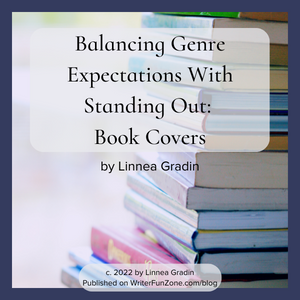 Today we welcome a new guest writer to Writer’s Fun Zone, Linnea Gradin who is stopping by to chat with us about “Balancing Genre Expectations With Standing Out: Book Covers.” Enjoy!
Today we welcome a new guest writer to Writer’s Fun Zone, Linnea Gradin who is stopping by to chat with us about “Balancing Genre Expectations With Standing Out: Book Covers.” Enjoy!
***
Book covers are vital for the success of a book as they guide readers and let them know what to expect.
An attention-grabbing cover is great, as long as it accurately reflects the story.
For example, people looking for romance don’t want the love interest brutally murdered on page 3.
A successful book cover toes the line between standing out and fitting in.
Let’s look at what that means.
Covers convey important informationIn order to create a book cover that stands out, you must first know the expectations of the market– and the genre.
MotifBrowse retailers to find out what motifs big publishers are using for your genre or subgenre.
Think both about what is physically on the page, and what is more abstractly communicated.
Does the cover feature a dark and desolate landscape, or some kind of tool that draws your mind to isolation and gruesome acts? Chances are it’s a crime thriller.
Are dragons, swords, or an imaginary world portrayed? Probably fantasy.
Illustrated human figures hint at contemporary romance, while period costume is a sure sign of historical romance.
You get the gist.
Some motifs are more subtle than others, so take some time to explore trends and save your favorite covers to send to future book cover designers as inspiration.
TypographyYou can also find genre trends in typography.
Expect to see more elaborate fonts for fantasy and some types of historical fiction, for instance.
Color schemeLastly, color scheme is used to capture the mood of a book or appeal to a certain audience.
Dark covers hint at creepy or thrilling content which may involve murder, fantastical beings, or suspense.
Though dour, they pop with details like gold foiling or contrasting colors for the title.
These vibrant colors, on the other hand, signal cozy, contemporary, bold, or even lighter-hearted reads.
While you may be tempted to use bright colors because they pop on the shelf, it’s probably not the way to go if you’ve written something dark and gritty.
Your target audience is likely to dismiss it, and vice versa!
Let’s look a bit closer at how you can work within these genre conventions.
To subvert, or not subvert?Once you have a good idea of the trends in your specific genre– its contours– it’s time to decide how you want to paint within those lines, or indeed outside them.
If you’re writing a memoir, for example, research will tell you that many of the best memoirs and biographies tend to have clean, simple covers featuring photographs– often from childhood or iconic moments– and emphasize typography.
With that in mind, you can focus on one or two things to make your cover stand out among the rest.
Take the cover of Why Didn’t You Tell Me?
The peeling photograph indicates that it belongs in the memoir genre, and the handwritten font creates an intimate feeling– as if we’re invited to read Wong’s old diaries.
It meets the target audience’s expectations while choosing a bold color and otherwise minimalist design.
Likewise, Picasso’s War playfully uses primary colors, coincidentally red again, to draw the eye and a font that references Picasso’s own signature for authenticity. But it stays well within genre conventions with its simple design and photograph of the artist.
It’s immediately clear that this is a biography, not a work of fiction.
On the other hand, Ingrid Rojas Contreras memoir goes against the grain with its abstract and busy design.
On a closer look, the reader will see that it still pays homage to genre convention by incorporating old photographs and newspaper clippings, successfully standing out while fitting in.
Finally, a second iteration of Jo Nesbø’s The Snowman also shows possibilities to play within the margins of the crime genre, keeping the dark color scheme but cleverly playing with minimalism and form.
Same ominous feeling, different method.
All four of these covers manage to balance expectation with individuality, to different degrees.
TakeawayUltimately, there’s no formula for how much you should deviate from convention, but it’s important that the cover matches the content.
After that, you can start thinking about ways to stand out — whether that be bright colors or a slightly off-balance composition that makes readers look twice.
***
ABOUT THE AUTHOR Linnea Gradin writes about writing and publishing over at Reedsy — a website that connects authors with publishing professionals and gives tips on topics such as how to self publish a book or how to translate a book.
Linnea Gradin writes about writing and publishing over at Reedsy — a website that connects authors with publishing professionals and gives tips on topics such as how to self publish a book or how to translate a book.
The post Balancing Genre Expectations With Standing Out: Book Covers by Linnea Gradin appeared first on Writer's Fun Zone.











